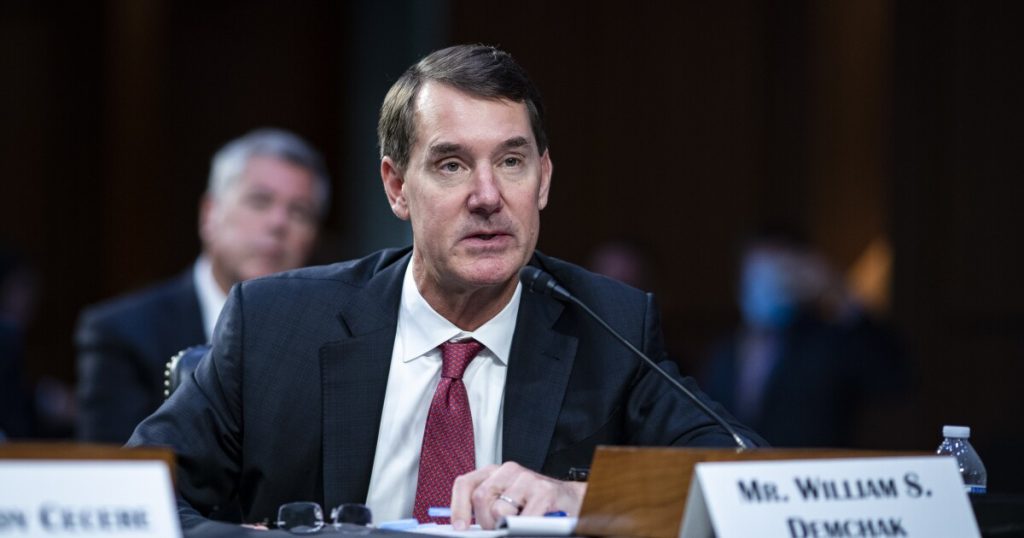- Key Insight: Discover why large banks aren’t buying each other.
- What’s at Stake: Large banks can use deals to expand in markets where they would otherwise have to grow organically.
- Forward Look: Smaller banks may continue to sell, but at higher valuations.
Big banks aren’t for sale.
That’s what
“People don’t want to sell,” Demchak said Tuesday at an industry conference. “They’re all buyers. People you think might be sellers are actually buyers. Interest rates are normalizing, credit is good. And I see no reason that you’re going to see anybody raise their hand and sell anytime soon. In fact, I’d be somewhat shocked by it.”
Demchak’s comments came on the heels of PNC’s Monday announcement that
On the flip side, the deal’s price to tangible book value multiple is estimated by analysts to be around 2.4, substantially higher than the 1.3 multiple on PNC’s acquisition of BBVA USA in 2021, though PNC is also trading at a higher multiple to its tangible book value.
The transaction doesn’t signal a new chapter of PNC buying smaller banks, according to Demchak, even though those are the bulk of what’s for sale.
“We don’t have a lot of interest in a typical smaller bank, in terms of where they’re valued today,” Demchak said. “So you see a lot of little banks getting together with, what I would suggest is, maybe, inflated currency.”
PNC is paying the $4.1 billion price tag for FirstBank with a 70-30 mix of stock and cash. And although the price to tangible book value is “steep,” the Pittsburgh-based bank can afford the cost because of its massive size relative to FirstBank, said Gerard Cassidy, co-head of global financials research at RBC Capital Markets.
Other bank leaders have also noted the rising costs of acquisitions, as well as the limited supply of for-sale institutions.
Old National Bancorp Chairman and CEO Jim Ryan said Monday at an industry conference that the multiple PNC paid was “eye-popping.”
“We are surprised a little bit, but I think you fish where the fish are,” he said. “And I think that’s what you’re seeing right now, is a reflection of what’s available versus what they’d maybe like to do.”
But PNC contends that the deal is exactly what it wanted. FirstBank ranked second in its asset-size tier on
“We just effectively bought Colorado,” Demchak said Tuesday.
The one hangup Demchak mentioned was that he wished PNC could have put more cash into the transaction to bring down the bank’s lofty capital ratio. But FirstBank preferred to be paid mainly in PNC stock.
PNC’s head of retail banking, Alex Overstrom, told American Banker on Monday that the acquisition will effectively “take 10 years of investments, and bring it forward to today” in the Phoenix and Denver markets. The combination will more than triple PNC’s branch footprint in Colorado, to 120. In Arizona, the bank’s branch count will grow to more than 70.
Cassidy told American Banker on Monday that PNC’s acquisition of FirstBank will boost PNC’s market share in Denver and Phoenix to levels that will likely enable the bank to outperform its peers on profitability.
“When opportunities present themselves, banks that want to build out scale, like PNC, have to assess the opportunity,” Cassidy said. “Should a $200-plus-billion in asset size bank put itself up for sale, I would expect PNC would certainly look at it and consider maybe acquiring it. But that’s obviously not happening today.”
Meanwhile, the FirstBank deal “dramatically” speeds up PNC’s expansion trajectory in markets where it was already hoping to build density, Cassidy said.
PNC isn’t the only large bank making a play for a substantially smaller institution.
Huntington Bancshares, with $207.7 billion of assets, recently announced plans to buy Veritex Financial in Dallas. The seller has fewer than 6% of the Ohio bank’s total assets, but
Still, despite analysts’ hunches that some
“If [a big bank deal] made sense for our franchise and it made sense for our shareholders and you actually had somebody who had any interest whatsoever in pursuing it with us, we’d look at it,” Demchak said. “None of that is true right now.”
